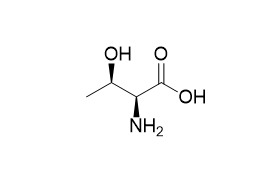DL-Threonine
DL-Threonine has nutritional effects. DL-Threonine does not contribute to the healing of blister bases but that it is of benefit in hypostatic leg ulceration.
Inquire / Order:
manager@chemfaces.com
Technical Inquiries:
service@chemfaces.com
Tel:
+86-27-84237783
Fax:
+86-27-84254680
Address:
1 Building, No. 83, CheCheng Rd., Wuhan Economic and Technological Development Zone, Wuhan, Hubei 430056, PRC
Providing storage is as stated on the product vial and the vial is kept tightly sealed, the product can be stored for up to
24 months(2-8C).
Wherever possible, you should prepare and use solutions on the same day. However, if you need to make up stock solutions in advance, we recommend that you store the solution as aliquots in tightly sealed vials at -20C. Generally, these will be useable for up to two weeks. Before use, and prior to opening the vial we recommend that you allow your product to equilibrate to room temperature for at least 1 hour.
Need more advice on solubility, usage and handling? Please email to: service@chemfaces.com
The packaging of the product may have turned upside down during transportation, resulting in the natural compounds adhering to the neck or cap of the vial. take the vial out of its packaging and gently shake to let the compounds fall to the bottom of the vial. for liquid products, centrifuge at 200-500 RPM to gather the liquid at the bottom of the vial. try to avoid loss or contamination during handling.
Molecules.2021, 26(9):2765.
Processes2024, 12(8), 1563
Food Bioscience2022, 50:102187.
Yakugaku Zasshi.2018, 138(4):571-579
Korean J. Food Preserv.2023, 30(4):663-668.
Anat Rec2018, 24264
Phytomedicine.2022, 110:154597.
Front Cell Dev Biol.2021, 9:638174.
Int J Mol Sci.2020, 21(9):3239.
Int J Anal Chem.2017, 2017:1254721
Related and Featured Products
Analytical Biochemistry, 2011, 409(1):130-137.
Enhancing electro-transformation competency of recalcitrant Bacillus amyloliquefaciens by combining cell-wall weakening and cell-membrane fluidity disturbing.[Reference:
WebLink]
Bacillus amyloliquefaciens has been a major workhorse for the production of a variety of commercially important enzymes and metabolites for the past decades. Some subspecies of this bacterium are recalcitrant to exogenous DNA, and transformation with plasmid DNA is usually less efficient, thereby limiting the genetic manipulation of the recalcitrant species.
METHODS AND RESULTS:
In this work, a methodology based on electro-transformation has been developed, in which the cells were grown in a semicomplex hypertonic medium, cell walls were weakened by adding glycine (Gly) and DL-Threonine (dl-Thr), and the cell-membrane fluidity was elevated by supplementing Tween 80. After optimization of the cell-loosening recipe by response surface methodology (RSM), the transformation efficiency reached 1.13 ± 0.34 × 107 cfu/μg syngeneic pUB110 DNA in a low conductivity electroporation buffer. Moreover, by temporary heat inactivation of the host restriction enzyme, a transformation efficiency of 8.94 ± 0.77 × 105 cfu/μg DNA was achieved with xenogeneic shuttle plasmids, a 103-fold increase compared to that reported previously. The optimized protocol was also applicable to other recalcitrant B. amyloliquefaciens strains used in this study.
CONCLUSIONS:
This work could shed light on the functional genomics and subsequent strain improvement of the recalcitrant Bacillus, which are difficult to be transformed using conventional methods.
British Journal of Dermatology, 1984, 111(s27):171-173.
The effects on wound healing of three amino acids-a comparison of two models[Reference:
WebLink]
We have utilized two different models to evaluate the role of the amino acids L-cysteine, glycine and DL-Threonine in wound healing.
METHODS AND RESULTS:
Both studies used a double-blind, placebo-controlled, randomized treatment plan. The first model involved the use of blister bases created on human forearm skin by the ammonium hydroxide technique, whilst the second model was that of hypostatic leg ulceration.
CONCLUSIONS:
We conclude that the amino acids did not contribute to the healing of blister bases but that they were of benefit in hypostatic leg ulceration.
Eiyo to Shokuryo, 1961, 14(2):100-104.
Effect of Addition of Lysine, Threonine, Tryptophan, and Methionine to Polished Rice on Rat Groth.[Reference:
WebLink]
METHODS AND RESULTS:
The nutritional effect of the addition of L-lysine, DL-Threonine, DL-tryptophan, and DL-methionine to polished rice was examined on rats fed on polished rice powder (protein content 5-6%) or on that added with protein extract from rice (protein content 18%) as the single protein source.The results of the experiments were summarized as follows.(1) The activity of the xanthine oxidase of the liver of rats fed on polished rice powder added with these amino acids increased in company with the growth of rats.
CONCLUSIONS:
The nutritional value was estimated to be almost equal to casein, and these observations indicated that the addition of these amino acids to polished rice powder offered a complete protein nutrition.(2) When the rice protein content was 18% of the total food, no significant difference was found in the growth of rats and the activity of xanthine oxidase between the group of rats fed on rice protein added with these amino acids and the group fed on diet without the additions.
Helvetica Chimica Acta, 1959, 42(1):209-212.
Eine neue Spaltung von Dl-Threonin in die optischen Antipoden.[Reference:
WebLink]
METHODS AND RESULTS:
A new resolution of DL-Threonine into the optical antipodes is effected by fractional crystallization of the stereoisomeric brucine salts of L- and D-N-phthaloyl-threonine in methyl-cellosolve.
CONCLUSIONS:
The two salts mentioned posses extraordinarily different degrees of solubility in methyl-cellosolve, and this allows the production of D- and L-threonine by simple operations in very high yield.



